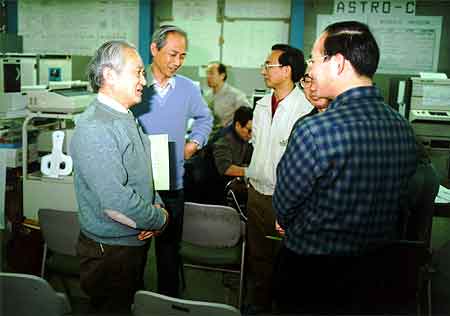| - Home page |
| - No.242 目次 |
| - 松尾弘毅 |
| - 田中靖郎 |
| - Riccardo Giacconi |
| - 西村 純 |
| - 栗原文良 |
| - 瓜本信二 |
| - 寿岳 潤 |
| - 宮本重憲 |
| - 野村民也 |
| - 林 友直 |
| - 平尾邦雄 |
| - 井上浩三郎 |
| - 原 宏徳 |
| - 牧島一夫 |
| - 井上 一 |
| + Ken Pounds |
| - 平山 淳 |
| - 森本雅樹 |
| - 戸田康明 |
| - 岩田冨美 |
| - 的川泰宣 |
| - 秋葉鐐二郎 |
| - 西田篤弘 |
| - 小田稔先生合同葬 |
| - ISAS事情 |
| - 編集後記 |
| - BackNumber |
Ken Pounds
Minoru Oda was the first person from Japan that I got to know, a long, warm and productive relationship beginning in 1967, when I spent the summer working with Riccardo Giacconi's group at American Science and Engineering and Dr Oda was with George Clark at MIT. Space Science was still a very young subject of course, and so naturally many scientific collaborations were just beginning. However, I believe I was Minoru's first link with the UK space community, a connection that was later to lead to a major collaboration between our two island nations.
The 1960s was a time of great excitement in X-ray astronomy, with research groups from the USA, Japan, Europe (and Australia) using the new sub-orbital research rockets to search the sky for additions to the handful of unexpectedly powerful cosmic X-ray sources still carrying the names of the host constellation. A major issue at the time, as subsequently with gamma ray bursters, was identification. There, Minoru Oda made an early and crucial contribution with the development of the modulation collimator, a technique yielding X-ray source positions of much improved precision. The resulting success in identifying Cygnus X-1 with a blue supergiant star led naturally to Oda's extended interest in that unique object. I suspect the early achievement of Japan's first space science satellite, Hakucho, launched in 1979 and led by Professor Oda, was driven by his determination to further explore such remarkable cosmic phenomena.
Viewed from the UK, the Japanese space science programme that rapidly developed under Minoru Oda's leadership, based first at Tokyo University and later at ISAS, was both familiar and enviable. The familiarity was in the approach, in which space experiments were designed and built by university researchers in their own laboratories. That approach contrasted with the much larger programmes in the USA and the Soviet Union. What increasingly we envied was the growth in funding in Japan, and particularly the independent launcher capability available to Japanese researchers. With hindsight the stage was well set, following our separate successes with Ariel 5 and 6, and with Hakucho and Tenma, for the first Japan-UK collaboration in X-ray astronomy, GINGA.

「ぎんが」誕生(1987年2月)
Astro-C was an ambitious project, aiming to orbit an X-ray detector array an order of magnitude larger than anything previously attemped in Japan or Europe, and comparable to the large NASA HEAO-1 mission. With the substantial, but much smaller resources at ISAS, Minoru Oda made the case to explore assistance from outside Japan. Happily for us in the UK, he decided our experience in building X-ray detectors for the Ariel satellites and EXOSAT was relevant and I was invited to visit Tokyo with senior officials from the UK Science Research Council in 1979. From the start, the relationship was a happy one, the collaboration building readily on the mutual trust and regard from both sides. The outcome - as they say - is history, with Astro-C being re-named as GINGA following a successful launch in February 1987 and going on to enjoy 4 near-flawless years as the major source of X-ray data for astronomers world-wide until re-entry in 1991.
In addition to the scientific impact of GINGA, the collaboration was widely referenced in the UK and Japan as a model of international cooperation. A longer-lasting benefit resulted from the exchange of scientists, particularly students, between our two countries, forming links that continue to underpin new joint endeavours today. Recalling the importance Minoru Oda placed on encouraging an outward-looking approach in Japanese science, I know he will have judged the latter benefit to be as important as the direct scientific returns from GINGA.
Humility is a measure of true greatness and Minoru Oda had this gift in full. During the early studies of Cygnus X-1, when a key target was to find a characteristic period in the X-ray emission, one of Minoru's students - who shall be nameless - produced a light curve from random data. As the supervisor examined the data, suggesting a period was indeed apparent, the truth was revealed. Minoru stood back, smiled and said that his student had taught him a lesson he would not forget. Those of us fortunate enough to have really known Minoru Oda will recall many happy memories, and our own valuable lessons, from that association.
He is greatly missed.
(University of Leicester)
